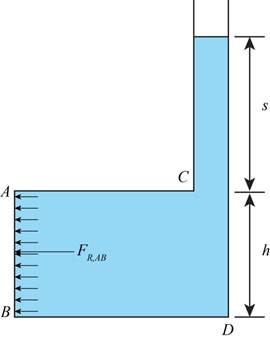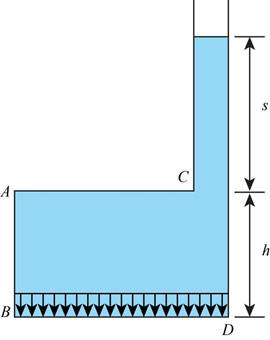
(a)
The magnitude of resultant force acting on surface
The location of line of action of resultant force.
Answer to Problem 83P
The magnitude of resultant force acting on surface
The location of line of action of resultant force is
Explanation of Solution
Given information:
The length of the tank is
Below figure represent the schematic and force acting on the tank.

Figure-(1)
Write the expression of pressure acting on the side
Here, the density of the fluid is
Write the expression of force acting on the side
Here, the frontal area is
Write the expression of frontal area of the tank.
Here, the width of the tank is
Write the expression of location of resultant force acting on the surface
Here, the distance from centroid is
Write the expression of moment of inertia about the centroid.
Write the expression of distance from the centroid of the surface.
Substitute
Calculation:
Substitute
Substitute
Substitute
Substitute
Conclusion:
The magnitude of resultant force acting on surface
The location of line of action of resultant force is
(b)
The pressure acting on surface
Weight of the oil in the tank.
Answer to Problem 83P
The pressure acting on surface
Weight of the oil in the tank is
Explanation of Solution
The below figure represent the pressure acting on the side

Figure-(2)
Write the expression of pressure acting on the bottom surface
Write the expression of force acting on the side
Here, the frontal area is
Write the expression of bottom surface area of the tank.
Here, the length of the tank is
Substitute
Write the expression of weight of the tank.
Here, the density of the oil is
Write the expression of volume occupied in the tank.
Write the expression of volume occupied in the column.
Here, the length of column is
Write the expression of density of the oil.
Here, the specific gravity of oil is
Substitute
Calculation:
Substitute
Substitute
Substitute
Conclusion:
The pressure acting on surface
Weight of the oil in the tank is
Want to see more full solutions like this?
Chapter 3 Solutions
Fluid Mechanics Fundamentals And Applications
- 2. Access plates on the industrial holding tank are bolted shut when the tank is filled with vegetable oil. Determine the resultant force that this liquid exerts on plate B, and its location measured from t he bottom of the tank. Use the Geothermal Method. P = 932 kg/ m^3 (Hibbeler, 2015). 4 m 4 m ,1.5 m 2.5 m 5 m 2 marrow_forward2.The water in a tank is pressurized by air, and the pressure is measured by a multifluid manometer as shown in figure. Determine the gage pressure of air in the tank if h: = 0.4 m, h₂ = 0.6 m, and h3 = 0.8 m. Take the densities of water, oil, and mercury to be 1000 kg/m³, 850 kg/m³, and 13,600 kg/m³. respectively. A. 103.69 kPa B. 97.81 kPa Air Water im C. 109.45 kPa D. 92.18 kPa Oil Mercuryarrow_forwardA 10-m high cylindrical container with a radius of 2 m is filled with oil and water. If the lower 2.5-m of the tank is water with a density of ρ = 1000 kg/m3 while the rest of the tank is filled with oil with a density of ρ = 800 kg/m3, determine the pressure difference, in kPa, between the top and bottom of the cylinder. Assume that the gravity is 9.81 m/s2.arrow_forward
- An object that has a Gs = 0.95 is found floating on a certain liquid with Gs = 1.06. If the volume of the exposed object is 950 cu.m, determine the total volume of the object.arrow_forwardA U-tube mercury manometer in communication with the 3-m radius spherical storage tank reads h = 1.0 m. If the atmospheric pressure is 101 kPa, the density of the mercury is 13.59 g/cm3, and g = 9.81 m/s2, determine the pressure of the natural gas in the storage, in kPa and psig.arrow_forward2. A circular ring (radius = 5.0 cm) is used to determine the surface tension of a liquid. The plane of the ring is positioned so that it is parallel to the surface of the liquid. The ring is immersed in the liquid and then pulled upward, so a film is formed between the ring and the liquid. In addition to the ring's weight, an upward force of 3.6 x 10 N is required to lift the ring to the point where it just breaks free of the surface. What is the surface tension of the liquid?arrow_forward
- Q2: The water in a tank is pressurized by air, and the pressure is measured by a multi fluid manometer as shown in the figure. Determine the air pressure in the tank if h1=0.1 m, h2=0.2 m, h3=0.35 m. Take the density of water, Oil and Mercury to be 1000, 850 and 13600 kg/m³, respectively, also atmospheric pressure is 85.6 kPa. Air Water h₂ oil mercuryarrow_forwardThe piston (Figure 2) has fluid on both sides. The gage pressure below the piston P = 30 kPa and the absolute pressure above the piston P2 = 100 kPa . What force F must be applied to the piston to keep it stationary? The diameter D = 5 cm . Neglect the magnitude of the force due to Patm acting on the rod relative to the magnitude of the force due to P2 acting on the piston. Express your answer in N to three significant figures. F D Rarrow_forwardConsider a differential manometer whose ends are connected to two different pipes A and B and containing different liquids at different levels. Let us assume that the pressure at point A is more than that at point B. Oil is in pipe A whose density 800 kg/m3 shows a difference in mercury levels as 100 mm. The height of oil between center of pipe A to the mercury level in left limb is 200 mm. Methanol (relative density = 0.791) is in pipe B and the height of Methanol between center of pipe B and mercury level in the right limb is 5 cm. Calculate the difference in pressures at the two points A and B.arrow_forward
- Both a gage and a manometer are attached to a gas tank to measure its pressure. If the reading on the pressure gage is 100 kPa, determine the distance between the two fluid levels of the manometer if the fluid isarrow_forwardScanned with CamScanner cross-sectional area of 35 cm². A compressed spring above the piston exerts a force of 150 N on the piston. If the atmos- pheric pressure is 95 kPa, determine the pressure inside the cylinder. Answer 147 kPa 150N P-95 kP. A=35 cm Scanned with CamScanner Both a gage and a manometer are attached to a O gas tank to measure its pressure. If the reading on the pressure gage is 80 kPa, determine the distance between the two fluid levels of the manometer if the fluid is (a) mer- 1000 kg/m'). I. 1-69 cury (p = 13,600 kg/m) or (h) water (p P = 80 kPa Gas HIGURE P1-69 Scanned with CamScanner CHAPTER I 1-72 A mercury manometer (p = 13,600 kg/m) is con- nected to an air duct to measure the pressure inside. The differ- ence in the manometer levels is 15 mm, and the atrmospheric pressure is 100 kPa. (a) Judging from Fig. P1-72, determine if the pressure in the duct is above or below the atmospheric pressure. (b) Determine the absolute pressure in the duct. Airarrow_forwardIsaiah measured the absolute pressure in water at a depth of 144 m to be 157 kPa. Now, he ask you to measure the absolute pressure at a depth of 144 m in another liquid whose specific gravity is 0.85 at the same location where Isaiah took his measurement for the water. What value in atm will you get? Take the density of water to be 1000 kg/m3.arrow_forward
 Elements Of ElectromagneticsMechanical EngineeringISBN:9780190698614Author:Sadiku, Matthew N. O.Publisher:Oxford University Press
Elements Of ElectromagneticsMechanical EngineeringISBN:9780190698614Author:Sadiku, Matthew N. O.Publisher:Oxford University Press Mechanics of Materials (10th Edition)Mechanical EngineeringISBN:9780134319650Author:Russell C. HibbelerPublisher:PEARSON
Mechanics of Materials (10th Edition)Mechanical EngineeringISBN:9780134319650Author:Russell C. HibbelerPublisher:PEARSON Thermodynamics: An Engineering ApproachMechanical EngineeringISBN:9781259822674Author:Yunus A. Cengel Dr., Michael A. BolesPublisher:McGraw-Hill Education
Thermodynamics: An Engineering ApproachMechanical EngineeringISBN:9781259822674Author:Yunus A. Cengel Dr., Michael A. BolesPublisher:McGraw-Hill Education Control Systems EngineeringMechanical EngineeringISBN:9781118170519Author:Norman S. NisePublisher:WILEY
Control Systems EngineeringMechanical EngineeringISBN:9781118170519Author:Norman S. NisePublisher:WILEY Mechanics of Materials (MindTap Course List)Mechanical EngineeringISBN:9781337093347Author:Barry J. Goodno, James M. GerePublisher:Cengage Learning
Mechanics of Materials (MindTap Course List)Mechanical EngineeringISBN:9781337093347Author:Barry J. Goodno, James M. GerePublisher:Cengage Learning Engineering Mechanics: StaticsMechanical EngineeringISBN:9781118807330Author:James L. Meriam, L. G. Kraige, J. N. BoltonPublisher:WILEY
Engineering Mechanics: StaticsMechanical EngineeringISBN:9781118807330Author:James L. Meriam, L. G. Kraige, J. N. BoltonPublisher:WILEY





